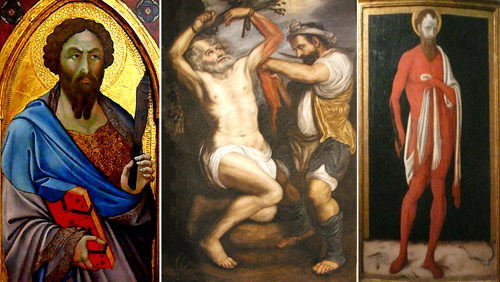Today, as some readers will be aware, is the feast day of St. Bartholomew, the Apostle of Jesus Christ (August 24th), and true to a popular traditional story, it has failed to rain here in Thurles today. This traditional story states “Of all the tears that St. Swithin can cry, St. Bartholomew’s Day will wipe them dry”.
To remind you: Readers will be aware of the St. Swithun’s day traditional story:
“St. Swithun’s day if thou dost rain,
For forty days it will remain.
St. Swithun’s day if thou be fair,
For forty days ’twill rain nae mare.* [*no more]
If on St. Swithun’s day it really pours,
You’re better off to stay indoors.”
So who was this St. Bartholomew.
St. Bartholomew, today, remains the patron saint of farmers, butchers, plasterers, housepainters, tanners, tailors, leatherworkers, bookbinders, and glove makers.
Legend describes St. Bartholomew as having black hair, a shaggy head, a fair skin, large eyes, beautiful nostrils, his ears hidden by the shaggy hair of his head, with a yellow beard, a few grey hairs, of middle height, and neither tall nor stunted, but middling, clothed with a white under cloak bordered with purple, and upon his shoulders a very white cloak, his clothes having been worn for twenty-six years, but neither are they dirty, nor have they become ragged.
In the New Testament St. Bartholomew’s name appears in the lists of apostles at Matthew 10:2-4, – Mark 3:17-19, – Luke 6:13-16, and Acts of the Apostles 1:13.
According to legend, after the death and Resurrection of Jesus Christ, St. Bartholomew preached the Gospel in India and Armenia, latter in the mountainous Caucasus region between Asia and Europe.
In one Indian city, which worshipped the vicious demon god Astaruth, his arrival is said to have held fast by ‘chains of fire’ this god called Astaruth, who no longer can speak or breathe.
Later, he exorcises the daughter of King Polemius, the former possessed and controlled by a demon, before cleansing the local temple by destroying all the idols and driving away all the demons that had resided, associated with them.
Enraged at this interference, pagan priests complained to King Polemius’s brother King Astarges, who arrests St. Bartholomew and has him put to death in Albana, latter a city in greater Armenia; some say by crucifixion, before adding greater torment by stripping him of his skin while still alive (flaying), and on his last breath having him decapitated, before being cast into the sea.
Some thirteen days after the apostles death, legend informs us that King Astreges himself was overpowered by a demon and strangled; as also were all the existing pagan priests.
St. Bartholomew’s stain glass portrait and his portraits painted in oil, usually show him with either a book and a flaying knife or being flayed (skinned alive) or being already flayed with his skin hanging around his skinless body. (See images shown above)


Leave a Reply